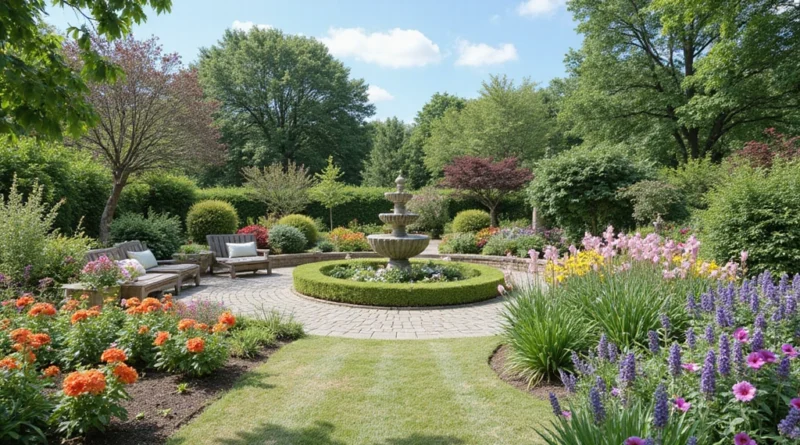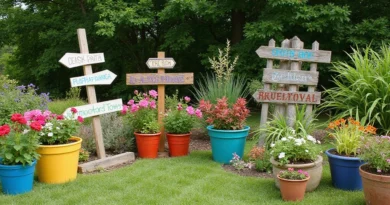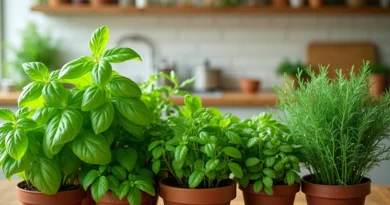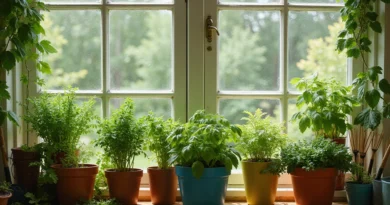How to Design the Perfect Garden Layout: Top Tips for a Beautiful Space
Creating a garden layout that’s both beautiful and functional can feel like a daunting task, but it doesn’t have to be! A well-planned garden can be a sanctuary, a place to unwind, and a feast for the eyes.
From choosing the right plants and understanding your space to incorporating textures and colors, each element plays a crucial role. A thoughtfully designed garden is not just about aesthetics; it’s about ensuring that each plant thrives and that you have space to move and enjoy. Let’s dig into ten essential tips for creating a garden layout that you’ll love!
1. Assess Your Space

Before planting anything, take a good look at your garden area. Measuring your space is vital; knowing the square footage allows you to decide how much you can plant. Consider factors like sunlight, shade, and wind exposure. These elements affect how plants grow and thrive.
Make sure to take note of any existing structures like trees, fences, or pathways that could impact your layout. You also should check your soil type; sandy or clay soils behave differently when it comes to planting. Sketching out your garden space on paper helps visualize your layout and decide where to place different plants based on their sunlight needs and growth habits.
– Make a list of plants you love.
– Create a rough sketch of your garden area.
– Note down sunlight and shade areas.
Understanding your space sets a solid foundation for the rest of your design process!
2. Choose a Focal Point

A garden is more than just plants; it’s about artistry and creating a focal point that draws the eye. This could be a stunning tree, a vibrant flower bed, or even an elegant water feature. Consider using sculptures or garden furniture as standout pieces.
A focal point helps guide the design and can even influence the layout of surrounding plants and paths. When selecting your focal point, choose something that resonates with your style. If you adore classic gardens, a blooming rose bush might be perfect; if you’re a fan of modern designs, sleek furniture could be the way to go.
– Decide on the shape and style that fits your garden theme.
– Use contrasting colors around your focal point to make it pop.
– Ensure that your focal point is visible from various angles.
Creating a stunning focal point can transform your garden into a masterpiece.
3. Create Zones for Different Activities

Think about how you want to use your garden. Are you looking for a quiet retreat, a place for entertaining, or perhaps a space for kids to play? Creating zones within your garden helps cater to these different activities.
You can designate areas for dining, relaxing, or even vegetable gardening. Use pathways or hedges to delineate these zones while keeping the overall flow intact. For instance, a cozy nook with comfortable chairs and a small table can be a spot for morning coffee, while a more open area can host family gatherings.
– Use furniture placement to define spaces.
– Include paths that encourage exploration through different zones.
– Add specific plants or features to enhance each zone’s purpose.
Zoning not only adds practicality to your garden but makes it feel more organized and intentional.
4. Incorporate Vertical Elements

Maximize your garden’s potential by incorporating vertical elements like trellises or arbors. These structures not only save space but also add height and interest to your layout. Climbing plants like clematis or wisteria can transform a plain wall into a stunning backdrop.
Vertical gardening is perfect for smaller spaces, allowing you to grow herbs, flowers, or even vegetables upwards. Integrate tall planters or hanging pots to bring different levels of plants into your design. This can create a beautiful layered effect that draws the eye upward.
– Choose sturdy supports for climbing plants.
– Mix different heights to create visual interest.
– Use vertical gardens to create privacy in your outdoor space.
Incorporating vertical elements can make your garden feel larger and more vibrant.
5. Plan for Seasonal Changes

A stunning garden changes with the seasons. Choose plants that bloom at different times to ensure your garden remains vibrant year-round. Early spring flowers, summer blooms, and autumn foliage can create a dynamic landscape.
Incorporate evergreen plants to maintain color even in winter months. Consider using seasonal features such as decorative pots or annual flowers that you can change out every few months. This way, your garden will continue to surprise and delight you all year long!
– Research native plants that thrive in your climate.
– Plan your layout to accommodate seasonal plants.
– Use mulch or decorative stones to enhance the look during off-seasons.
A garden that changes with the seasons offers variety and keeps your outdoor space feeling fresh.
6. Add Pathways for Accessibility

Pathways are crucial in any garden layout, improving accessibility and guiding movement through the space. They can be created using gravel, stones, or even pavers, and their design should match the overall aesthetic of your garden.
Consider how you want to navigate your garden. Curved paths can create a sense of wonder while straight ones provide a more formal look. Make sure your paths are wide enough for comfortable walking and consider adding curves to create a sense of flow.
– Use natural materials to blend with the garden.
– Create pathways that lead to different zones or focal points.
– Add subtle lighting along paths for evening enjoyment.
Thoughtfully placed pathways enhance usability and contribute to the overall beauty of your garden.
7. Mix Textures and Colors

A visually appealing garden layout combines various textures and colors. Mixing leaves, flowers, and hardscape can create depth and keep things interesting. Think about using plants with different foliage shapes, sizes, and colors.
Pair soft, feathery plants with bold, structured ones for contrast. Color is just as important; consider using complementary colors or even a monochromatic scheme to create unity. This layering of textures and colors makes your garden feel alive and engaging.
– Plan for plants that bloom in complementary colors.
– Use rocks, wood, and metal to add different textures.
– Don’t be afraid to experiment with color combinations!
Mixing textures and colors can transform your garden into a vibrant tapestry that feels cohesive and inviting.
8. Select the Right Plants for Your Climate

Choosing plants suited to your local climate is essential for a thriving garden. Native plants are great options as they adapt naturally to the local environment and require less maintenance. Research your USDA plant hardiness zone to see which plants will thrive.
Consider drought-resistant species if you live in a dry area or moisture-loving plants if your area tends to be wet. Choose a mix of perennials and annuals for more extended beauty and blooms. This not only simplifies your gardening routine but also promotes local ecosystems.
– Look for local gardening guides or resources.
– Consult with local nurseries for plant recommendations.
– Incorporate plants that attract beneficial pollinators.
Selecting the right plants ensures your garden flourishes and supports local wildlife.
9. Create Edible Spaces

Incorporating edible plants into your garden not only beautifies the space but offers delicious rewards! Veggies, herbs, and fruit-bearing plants can be included in your layout while still maintaining aesthetics. Consider a herb spiral or dedicated raised beds for easy access.
Mixing edible plants among ornamental ones can create a visually appealing display. Think about companion planting, where certain plants benefit each other’s growth. For instance, tomatoes and basil look great together and can thrive in close proximity.
– Choose plants that complement each other.
– Plan for easy access to harvest and care.
– Use decorative pots for herbs on patios or decks.
Creating edible spaces is not just practical; it adds flavor to your gardening experience!
10. Don’t Forget to Enjoy Your Space

Once your garden is laid out and flourishing, take time to enjoy it! Adding furniture or cozy corners can encourage you to spend more time in your outdoor space. A simple bench under a tree or a hammock can become your favorite relaxation spot.
Remember to maintain your garden regularly; this helps keep it looking its best and makes it enjoyable. Hosting friends for a garden party or simply enjoying a cup of coffee in your blossoming space can bring immense joy. Your garden is meant to be appreciated, so don’t hesitate to use it!
– Include comfortable seating.
– Create shaded areas for warmth.
– Plan for seasonal decorations or events.
Enjoying your garden is the ultimate reward for your hard work and planning!
Conclusion

Designing the perfect garden layout is about balancing beauty, functionality, and enjoyment. Each tip offers a stepping stone toward creating a space that resonates with your style while catering to your lifestyle.
Whether you’re a seasoned gardener or just starting, remember each garden tells a story. So take your time, enjoy the process, and let your creativity bloom!



